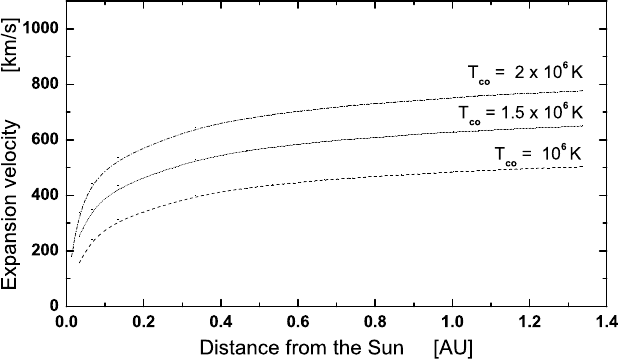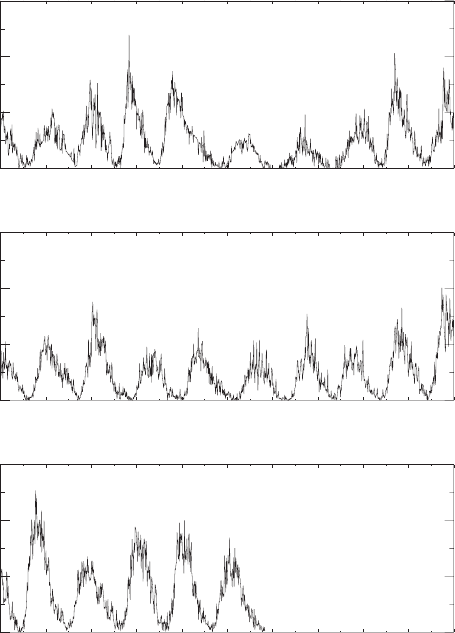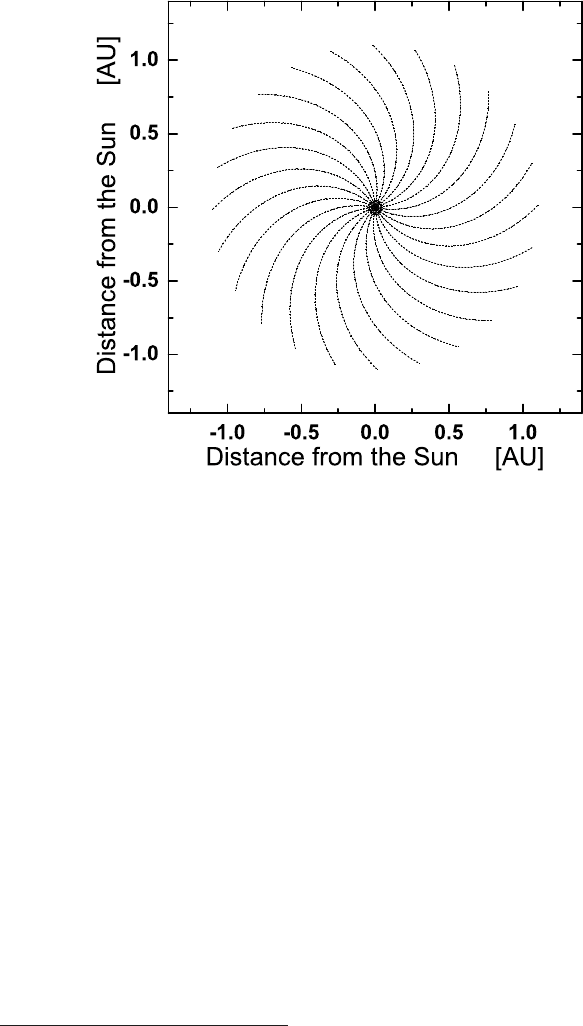Leroy C., Rancoita P.-G. Principles Of Radiation Interaction In Matter And Detection
Подождите немного. Документ загружается.


January 9, 2009 10:21 World Scientific Book - 9.75in x 6.5in ws-bo ok975x65˙n˙2nd˙Ed
300 Principles of Radiation Interaction in Matter and Detection
in space, one of the primary effects of degraded operations is the reduction of the
current gain.
In the following sections, we present a review about i) the origin of the solar wind
and heliospheric (or interplanetary) magnetic-field (Sect. 4.1.2.1), ii) the extension
of the heliosphere and the Earth magnetosphere (Sect. 4.1.2.2), iii) how the solar
wind affects (modulates) the propagation of galactic cosmic rays in the heliosphere
(Sect. 4.1.2.3), iv) fluxes of solar, heliospheric and galactic cosmic rays (Sect. 4.1.2.4)
and v) a description of trapped particles in the Earth magnetosphere (Sect. 4.1.2.5).
4.1.2.1 Solar Wind and Heliospheric Magnetic Field
Nowadays, we know that the solar wind (SW) is a plasma
††
that permeates the
interplanetary space and constitutes the interplanetary medium. It is, as discussed
later, the outer part of the Sun’s corona
¶
streaming through the solar system and
creating the so-called solar cavity (also termed heliosphere). It is highly variable in
both time and space; it consists
†
of protons (about 95% of the positively charged
particles), double charged helium ions, a very small number of other positively
charged particles and electrons, so that the plasma is electrically neutral. At the
orbit of Earth, i.e., at 1 AU from the Sun (see Appendix A.2), experimental obser-
vations of SW allowed one to determine that i) the proton density and temperature
are ≈ (8–9) proton/cm
3
and ≈ 1.2 × 10
5
K, respectively, ii) the mean wind speed
is ≈ 470 km/s, iii) the mean speed of sound is (50–63) km/s (e.g., see Table 3-1
of [Feynman (1985)], Table 1 of [Gosling (2006)] and references therein) and, thus,
iv) the SW speed is supersonic
‡‡
. It carries an embedded weak magnetic-field, which
results in modulating the fluxes of GCRs entering the heliosphere. It has to b e noted
that until the early 1990s our knowledge of the heliosphere was limited to the eclip-
tic plane. In fact, the investigation of plasma, particles and field in the polar regions
of the Sun were among the main goals of the Ulysses mission, launched in 1990.
In 1859, the first SW (indirect) observation was made by Carrington, who wit-
nessed what is now called a solar flare
∗
and noted that a major geomagnetic storm
began about 17 hours after the flare. In 1896, Birkeland suggested that the Earth
environment is bombarded by “rays of electric corpuscles emitted by the Sun”. In
the early 1900s, Lindemann suggested that geomagnetic storms may result from an
interaction of the geomagnetic-field and plasma clouds ejected by the solar acti-
††
The plasma is an ionized gas, electrically quasi-neutral and exhibiting collective behavior
(e.g., see Chapter 2 of [Meyer-Vernet (2007)]).
¶
The corona with temperatures over 10
6
K is a highly rarefied region above a small region called
chromosphere, which extends for ≈ 2000 km above the photosphere. The photosphere, in turn, is
a thin layer at the surface of the Sun. The reader may find an introduction to the Sun structure,
for instance, in [Aschwanden (2006)].
†
The reader can find details of solar wind composition, for instance, in [Feynman (1985); Gosling
(2006)]).
‡‡
The sonic point, i.e., the position at which the solar wind speed becomes equal to the speed of
sound, is located at several solar radii (R
J
).
∗
The solar flare is a giant explosive energy release on the Sun.

January 9, 2009 10:21 World Scientific Book - 9.75in x 6.5in ws-bo ok975x65˙n˙2nd˙Ed
Radiation Environments and Damage in Silicon Semiconductors 301
vity. In the 1930s, Forbush noted a rapid decrease (the so-called Forbush decrease)
in the observed GCR intensity following a coronal mass ejection. It o ccurs, as we
know now, due to the magnetic field of the SW plasma sweeping some of the galac-
tic cosmic rays away from Earth. In the early 1950s, Biermann concluded that
there must be a steady stream of charged particles from the Sun to account for the
fact that ionic tails of comets always point away from the Sun. In the mid 1950s,
Chapman constructed a static solar corona model and calculated the properties of
a low-density gas at ≈ 10
6
K: he determined that this latter is an excellent con-
ductor of heat and must extend way out into space, beyond the orbit of Earth. In
other words, the Earth is expected to be inside the solar corona. These results and
observations inspired Parker (1958)
§
to formulate a radically new model of the so-
lar corona in which this later is continuously expanding outward, thus solving the
discrepancy between the estimated interstellar pressure of (10
−12
–10
−13
) dyn/cm
2
(e.g., see [Parker (1958)], pages 8–11 of [Toptygin (1985)] and Table 1 of [Suess
(1990)]) and that of ≈ 0.6 ×10
−5
dyn/cm
2
[Parker (1958)], computed under the as-
sumption of a static equilibrium in the solar corona (see, also, [Parker (2007)]). Since
then, Parker’s model has demonstrated to provide a general and elegant framework
for heliospheric features. However (e.g., see [Fisk (2001); Cranmer (2002)] and re-
ferences therein), subsequently this model was modified to account additional ob-
servations, like for instance those obtained with i) the Ulysses spacecraft (launched
by the Space Shuttle Discovery in 1990, as already mentioned) designed to reach
high solar latitudes, thus out of the ecliptic plane and ii) the Solar and Heliospheric
Observatory (SOHO, launched in 1995) to study the Sun from its deep core to outer
corona and the SW.
As mentioned above, Parker (1958) assumed that i) the solar corona was not in
hydrostatic equilibrium, ii) there is a stationary expansion with the coronal plasma
flowing out, iii) the stationary expansion is spherically symmetric, iv) the kinetic
temperature of the gas is maintained (by heating mechanisms) at a uniform value T
0
from the base of the corona at radial distance r
co
≈ 10
6
km to some radius beyond
which the heating vanishes and T is negligible, v) electrons and protons are the
dominant (and equal in number) particles of the solar coronal plasma, and vi) the
stationary expansion satisfies the equation of motion
¶
ρv
dv
dr
= −
dP
dr
− Gm
J
ρ
r
2
, (4.3)
where r is the radial distance; G and m
J
are the Newtonian constant and solar
mass, respectively (see Appendix A.2); P is the pressure; v is the radial velocity of
the corona expansion; the mass density is given by
ρ = n
pl
(m
p
+ m
e
) = n
pl
m ≈ n
pl
m
p
, (4.4)
§
This article on Parker’s theory about the SW was submitted to Astrophysical Journal, but was
rejected by the two reviewers. It was saved by then editor Chandrasekhar (1983 Nobel Prize in
physics). Parker received the Kyoto and James Clerk Maxwell Prizes in 2003.
¶
This equation is the Bernoulli equation for the solar corona expansion and reduces to the so-
called barometric equation, when the first term is 0 (i.e., for dv/dr = 0). The barometric equation
accounts for hydrostatic equilibrium.

January 9, 2009 10:21 World Scientific Book - 9.75in x 6.5in ws-bo ok975x65˙n˙2nd˙Ed
302 Principles of Radiation Interaction in Matter and Detection
in which m
p
(m
e
) is the proton (electron) rest-mass and, thus,
m = m
p
+ m
e
≈ m
p
;
n
pl
is the number of protons (or electrons, since the gas is assumed to b e neutral
and fully ionized) per cm
3
and satisfies the equation of continuity
d
dr
¡
n
pl
vr
2
¢
= 0 (4.5)
for conservation of matter. For an ideal (mono-atomic) gas with equal electron and
proton temperatures, the pressure is given by
P = 2 n
pl
k
B
T,
where k
B
is the Boltzmann constant (Appendix A.2), and the (local) sound speed
k
is
v
sd
=
s
dP
dρ
. (4.6)
Equation (4.3) yields a p ositive expansion velocity, v, as a function of the radial
distance, r, for r ≥ r
co
when [Parker (1958)]
mv
2
2 k
B
T
0
− ln
µ
mv
2
2 k
B
T
0
¶
= −3 − 4 ln
µ
Gmm
J
4 r
co
k
B
T
0
¶
+4 ln
µ
r
r
co
¶
+
Gmm
J
rk
B
T
0
. (4.7)
In Fig. 4.4, it is shown the expansion velocity, v(r), obtained using Eq. (4.7) for
an isothermal solar corona with temperatures T
0
= 10
6
, 1.5 × 10
6
and 2 × 10
6
K
and r
co
≈ 10
6
km at the base. Furthermore, Parker extended his treatment to i) the
case in which the pressure and temperature are related by the polytropic law [Parker
(1960, 1963)]
P = P
0
µ
ρ
ρ
0
¶
α
, (4.8)
where α is the polytropic index (for instance, α = 1 and α = 5/3 for isothermal
and adiabatic processes, respectively) and ii) the case of sudden corona-expansion
following a large solar flare [Parker (1961a)]. The hydrodynamic expansion of the
coronal plasma was termed the solar wind for the Sun and the stellar wind for the
other stars by Parker (1960).
For approaching the description of a more complex three-dimensional SW struc-
ture as presently observed ([McComas, Elliott, Schwadron, Gosling, Skoug and
Goldstein (2003)] and references therein), further discussions, criticisms and, also,
improvements to Parker’s model can be found, e.g., in [Parker (1961a, 1963);
k
Using Eqs. (4.6, 4.8), the local sound speed can be rewritten as v
sd
=
p
α(P/ρ). Thus, the
wavespeed depends on the conditions under which the compression takes place. For example,
in case of an adiabatic compression of a monoatomic gas we have α = 5/3 and, consequently,
v
sd
=
p
(5P /3ρ) (e.g, see Sections 17.3 and 21.5 of [Ingard and Kraushaar (1960)]).

January 9, 2009 10:21 World Scientific Book - 9.75in x 6.5in ws-bo ok975x65˙n˙2nd˙Ed
Radiation Environments and Damage in Silicon Semiconductors 303
Fig. 4.4 Spherically symmetric hydrodynamic expansion velocity (i.e., the velocity of the solar
wind) in km/s as a function of the radial distance (in AU) from the Sun, for an isothermal corona
with temperatures T
0
of 10
6
, 1.5 × 10
6
and 2 × 10
6
K and a radius of ≈ 10
6
km at the base.
Hundhausen (1972); Feynman (1985)], Chapter 6 of [Cravens (1997)], Chapter 12
of [Gombosi (1998)], Chapter 6 of [Kallenrode (2004)] and Chapter 6 of [Parks
(2004)] (see, in addition, references therein). Limitations of this model are related,
for instance, to i) observations that the pressure is less isotropic as the plasma
moves away from the Sun, ii) the assumption that the flow is considered uniform
and radial and iii) proton and electron temperatures, which were assumed equal and
isotropic. For example, measurements have determined the presence of a fast solar
wind component, where electrons have a core component with a nearly Maxwellian
(kinetic) energy distribution and a high-energy tail (the so-called halo component),
which has an approximate Maxwellian distribution with a temperature larger by
about an order of magnitude with respect to that of the core component. Although
not all issues can be treated from the particle point of view, some of these features
motivated some authors (e.g., [Lemaire and Scherer (1973); Maksimovic, Pierrard
and Lemaire (2001)] and Section 6.7.4 of [Parks (2004)]) to investigate the so-called
kinetic models of the SW. However, detailed treatments of alternative or extended
solar wind models go beyond the purpose and fields of applications of the present
bo ok.
As already mentioned, in Parker’s model the magnetic-field lines are supposed
to be embedded in the streaming particles of the SW. The notion of frozen-in
magnetic-field originates from the work on electromagnetic hydrodynamic waves

January 9, 2009 10:21 World Scientific Book - 9.75in x 6.5in ws-bo ok975x65˙n˙2nd˙Ed
304 Principles of Radiation Interaction in Matter and Detection
by Alfv´en
∗
(1942) and plays a relevant role in the description of interplanetary
magnetic-field [Parker (1957, 1958)] and planet magnetospheres. Alfv´en noted that
the motion of matter can be coupled to the modification of the magnetic-field lines,
so that these latter follow the matter motion. In magnetohydrodynamics (MHD), we
can express the time derivative of the magnetic field
~
B as a function of the electric
field,
~
E, and the center-of-mass plasma-velocity, ~v
pl
, in the laboratory
††
. In fact
using the so-called generalized Ohm’s law and since the Hall, ambipolar polarization
and inertial terms can be neglected (e.g., see Sections 4.3.1 and 4.3.2 of [Cravens
(1997)]), we have
∂
~
B
∂t
= −∇ ×
Ã
~
J
℘
−~v
pl
×
~
B
!
= −∇ ×
~
J
℘
+ ∇ ×
³
~v
pl
×
~
B
´
, (4.9)
where ℘ is the conductivity and
~
J is the current density. For slow time-variations
and non-relativistic plasma bulk-speeds
‡
, the term (1/c
2
) ∂
~
E/∂t can be neglected
in Maxwell’s equation regarding ∇ ×
~
B, i.e., we have
∇ ×
~
B = µ
0
~
J +
µ
1
c
2
¶
∂
~
E
∂t
≈ µ
0
~
J
⇒
~
J ≈
1
µ
0
∇ ×
~
B,
where µ
0
is the permeability of the free space (see Appendix A.2). Thus, using
a vector calculus identity we can rewrite the first term of the right-hand side of
Eq. (4.9) as
−∇ ×
~
J
℘
≈ −
1
µ
0
℘
∇ × ∇ ×
~
B
= −
1
µ
0
℘
h
∇
³
∇ ·
~
B
´
− ∇
2
~
B
i
=
∇
2
~
B
µ
0
℘
,
since
∇ ·
~
B = 0.
∗
Alfv´en, who got the Nobel prize in 1970, criticized how the concepts of frozen-in magnetic-field
lines and field-line reconnection were used in the theory of magnetosphere (e.g., see [Alfv´en (1976)]
and references therein).
††
For the interplanetary magnetic-field, the laboratory reference-frame is that of the solar cavity.
‡
For example, these conditions are satisfied for a velocity (v
pl
), a time-scale (τ
ch
) and a length-
scale (L
ch
) such that
τ
ch
À
v
pl
L
ch
c
2
;
for a discussion, the reader can see, for instance, Section 2.3.3 of [Meyer-Vernet (2007)].

January 9, 2009 10:21 World Scientific Book - 9.75in x 6.5in ws-bo ok975x65˙n˙2nd˙Ed
Radiation Environments and Damage in Silicon Semiconductors 305
Finally, Eq. (4.9) can be rewritten as
∂
~
B
∂t
=
∇
2
~
B
µ
0
℘
+ ∇ ×
³
~v
pl
×
~
B
´
. (4.10)
For a plasma composed by i) electrons with rest-mass m
e
and concentration n
e
and
ii) (an equal amount of) single ionized ions with rest-mass À m
e
and concentration
n
ion
= n
e
= n
pl
,
the electrical conductivity
§
is given by
℘ ≈
e
2
n
pl
m
e
ν
coll
, (4.11)
where ν
coll
is the collision frequency and e is the electron charge. In addition
{e.g., see Equation (2.102) of [Meyer-Vernet (2007)]}, ℘ is approximated by
℘ ≈ 6 × 10
−4
× T
3/2
[Ω m]
−1
, (4.12)
whenever the magnetic-field effect can be neglected, i.e., in the direction i) parallel
to
~
B and ii) perpendicular to
~
B, if the particle mean free-path is much smaller than
the radius of gyration. In general along this latter direction, the opposite condition
occurs and, consequently, the electric conductivity results to be strongly reduced
perp endicularly to
~
B. The quantity
D
B
=
1
℘µ
0
=
m
e
ν
coll
e
2
n
pl
µ
0
(4.13)
is the so-called magnetic diffusion coefficient. Equation (4.10) is known as the
magnetic convection-diffusion equation and accounts for two contributions to the
magnetic-field variation: these are due to the a) diffusion, produced by conductive
losses (i.e., the first term), and b) convection, produced by the plasma bulk mo-
tion (i.e., the second term). Furthermore, the ratio of the magnetic convection and
diffusion term
R
m
=
magnetic convection term
magnetic diffusion term
(4.14)
is termed magnetic Reynolds number and can be estimated from the expression
(e.g., see Section 4.4.2 of [Cravens (1997)] or page 88 of [Meyer-Vernet (2007)])
R
m
≈
v
pl
L
ch
D
B
= v
pl
℘µ
0
L
ch
,
where the length-scale L
ch
is defined in the footnote at page 304. For R
m
À 1 the
magnetic diffusion term can be neglected in Eq. (4.10), which reduces to
∂
~
B
∂t
≈ ∇ ×
³
~v
pl
×
~
B
´
. (4.15)
§
The reader can see, e.g., Section 4.3.2 of [Cravens (1997)], Section 4.3.2 of [Gombosi (1998)], Sec-
tions 2.1.3 and 2.3.3 of [Meyer-Vernet (2007)].

January 9, 2009 10:21 World Scientific Book - 9.75in x 6.5in ws-bo ok975x65˙n˙2nd˙Ed
306 Principles of Radiation Interaction in Matter and Detection
When the magnetic convection-diffusion equation is reduced to Eq. (4.15), we are in
the condition of a perfectly conducting-fluid moving in a magnetic field, for which it
can be proven
∗
that the magnetic flux through any closed contour moving with the
plasma is constant. Thus, the fluid can move freely along the magnetic-field lines
and these latter are frozen in the fluid (e.g., see [Parker (1957)] and, also, Chapter 4
of [Cravens (1997)], Section 14.4.2 of [Gombosi (1998)], Section 3.4 of [Kallenrode
(2004)], Section 5.5.1 of [Parks (2004)], [Lundin, Yamauchi, Sauvaud and Balogh
(2005)] and references therein, Section 2.3.2 of [Meyer-Vernet (2007)]).
For the SW non-relativistic plasma, it can be shown that ℘ is large and R
m
À 1
(e.g., see page 291 of [Meyer-Vernet (2007)]) and, thus, the SW can flow with a
frozen-in magnetic-field. Furthermore, in the SW at 1 AU from the Sun the mean
free path among streaming particles is ≈ 1 AU, as a consequence, particle collisions
can hardly occur (e.g., see page 53 of [Meyer-Vernet (2007)]).
The first indication of a solar magnetic-field was obtained in 1905 by Hale. He
could demonstrate the presence of strong magnetic-fields in sunspots by means of
the Zeeman effect. These sunspots are supposed to be created deeper in the Sun
†
and, afterwards, moved to the surface by magnetic-buoyancy effects. A large spot
is about 2 × 10
4
km across and may have a central umbra-region with a tempera-
ture of ≈ 4.1 × 10
3
K (e.g., see Section 1.3 in [Priest (1985)]). Daily observations
were started at the Zurich Observatory in 1749. Their number varies and increases
with the solar activity following a cycle of ≈ 11 years duration termed the sunspot
cycle: the cyclic variation of the number of sunspots [also called the (Schwabe)
solar cycle or Schwabe–Wolf cycle] was first observed by Heinrich Schwabe between
1826 and 1843 and led Rudolf Wolf to make systematic observations starting in
1848 (Fig. 4.5)). The relative sunspot number
‡
(R
s
) remains an important index for
determining the solar activity level; it is computed using the formula (collected as
a daily index of sunspot activity):
R
s
= k
ob
(s + 10 × g), (4.16)
where s is the number of individual spots, g is the number of sunspot groups and,
finally, k
ob
is a factor that varies with location and instrumentation (also known as
the observatory factor). Furthermore, sunspots are used to trace the Sun surface-
rotation since Galileo in 1611. Nowadays, it is determined that the Sun rotation-
period is a function of the solar latitude and is called (sidereal) differential rota-
∗
This is known as Alfv´en’s theorem.
†
The reader can find a general description of the Sun characteristics, for instance, in [Altrock et
al. (1985)] and in [Aschwanden (2006)].
‡
R
s
is also known as the International sunspot number or Z¨urich number or Wolf num-
ber. Note that there are actually at least two ”official” sunspot numbers reported. The In-
ternational Sunspot Number is compiled by the Sunspot Index Data Center in Belgium
(http://sidc.oma.be/index.php). The NOAA sunspot number is compiled by the US Na-
tional Oceanic and Atmospheric Administration. The sunspot numbers and smoothed monthly
mean sunspot numbers can be found at the web site: ftp://ftp.ngdc.noaa.gov/ftp.html or
http://www.ngdc.noaa.gov/stp/SOLAR/ftpsunspotnumber.html#international (the reader can
also see: http://solarscience.msfc.nasa.gov/SunspotCycle.shtml).

January 9, 2009 10:21 World Scientific Book - 9.75in x 6.5in ws-bo ok975x65˙n˙2nd˙Ed
Radiation Environments and Damage in Silicon Semiconductors 307
1750 1760 1770 1780 1790 1800 1810 1820 1830 1840 1850
DATE
0
100
200
300
SUNSPOT NUMBER
1850 1860 1870 1880 1890 1900 1910 1920 1930 1940 1950
DATE
0
100
200
300
SUNSPOT NUMBER
1950 1960 1970 1980 1990 2000 2010 2020 2030 2040 2050
DATE
0
100
200
300
SUNSPOT NUMBER
NASA/MSFC/NSSTC/HATHAWAY 2008/06
Fig. 4.5 Monthly averages (updated monthly) of the sunspot numbers show that the number
of sunspots visible on the sun waxes and wanes with an approximate 11-year cycle (Courtesy
NASA; see the web site http://solarscience.msfc.nasa.gov/SunspotCycle.shtml).
tion. The sidereal rotation can be approximated by
ω = 14.522 − 2.84 × sin
2
b [deg/day], (4.17)
where b is the heliographic latitude (see page 77 of [Aschwanden (2006)] and
also [Brajˇsa et al. (2001)]). An effective rotation period of ≈ 27 days is usually
satisfactory to indicate most of the Sun rotation-recurrences. In addition, the Sun’s
rotation axis is tilted by ≈ 7
◦
from the axis of the Earth’s orbit.
H.D. and H.W. Babcock (1954) observed the Sun magnetic-field over a two
years period (1952–1954) using an instrument (called the solar magnetograph) uti-
lizing the Zeeman effect and established that the Sun has a general magnetic dipole

January 9, 2009 10:21 World Scientific Book - 9.75in x 6.5in ws-bo ok975x65˙n˙2nd˙Ed
308 Principles of Radiation Interaction in Matter and Detection
Fig. 4.6 Configuration of the interplanetary magnetic-field (following the the so-called
Archimedean spiral shape) for the Parker model as a function of the radial distance (in AU)
from the Sun in the solar equatorial plane for i) a steady solar wind with velocity of 470 km/s from
r
b
≈ 10 R
J
and ii) an angular velocity of 2.9 × 10
−6
rad/s for the solar rotation at equator.
field of ≈ 10
−4
T distributed over the visible photosphere
∗
. The magnetic-dipole
tilt with respect to the rotation axis varies and depends on the solar cycle: appar-
ently the magnetic polarity is reversed (e.g., see [Jones, Balogh and Smith (2003)]
and references therein) about every 11 years with the evolution of the solar cycle,
i.e., a similar magnetic configuration is found about every 22 years (the so-called
Hale cycle or solar magnetic cycle). Parker (1958) (see also [Parker (1957, 1960,
1961a, 1963, 2007)]) suggested that the solar magnetic-field is frozen-in to the flow
of the SW non-relativistic plasma, which carries the field with it into interplane-
tary space and generates the so-called interplanetary magnetic-field (IMF) or helio-
spheric magnetic-field (HMF). He assumed i) a constant solar rotation with angular
velocity ω
c
, ii) a simple spherically symmetric emission of the SW (see page 301)
and iii) a constant (or approaching an almost constant) wind speed, v
w
, at larger
radial distances, e.g., for r > r
b
≈ 10 R
J
§
, since beyond r
b
the wind speed varies
slowly with the distance (see Fig. 4.4). This latter assumption is justified because
both the solar gravitation and the outward acceleration by high coronal tempera-
ture may be neglected or affect marginally the wind speed for r & r
b
. Thus, in a
∗
The photosphere is the apparent solar surface with a diameter usually considered to be the
diameter of the Sun. The photosphere thickness is ≈ 0.014% of R
J
.
§
R
J
≈ 4.65 × 10
−3
AU is the solar radius, see Appendix A.2.

January 9, 2009 10:21 World Scientific Book - 9.75in x 6.5in ws-bo ok975x65˙n˙2nd˙Ed
Radiation Environments and Damage in Silicon Semiconductors 309
spherical system of coordinates (r, θ , φ) rotating with the Sun, the outward velocity
of a fluid element carrying the magnetic field is approximately
¶
given by [Parker
(1958)]
v
r
= v
w
,
v
θ
= 0,
v
φ
= −(r − r
b
) ω
c
sin θ.
(4.18)
Since from Eq. (4.18) and for r À r
b
we can write
v
φ
v
r
= r
dφ
dr
=
−rω
c
sin θ
v
w
, (4.19)
the streamline with azimuth φ
0
at r
b
is obtained after integrating the previous
expression, i.e.,
Z
r
r
b
dr
0
= −
Z
φ
φ
0
v
w
ω
c
sin θ
dφ
0
⇒ r = r
b
−
v
w
ω
c
sin θ
(φ − φ
0
) . (4.20)
The “spiral angle” (ψ
sp
) is the angle that the heliospheric magnetic-field line makes
to the radial direction and, from Eq. (4.19), is given by
ψ
sp
= tan
−1
¯
¯
¯
¯
v
φ
v
r
¯
¯
¯
¯
; (4.21)
for instance, in the ecliptic plane it becomes
ψ
sp,e
' tan
−1
µ
rω
c
v
w
¶
.
Furthermore, since the plasma velocity is parallel to the magnetic field, the ratios
of the corresponding φ and r components are same [e.g., see Eqs. (4.18), (4.22)]:
B
φ
(r, θ, φ)
B
r
(r, θ, φ)
=
v
φ
v
r
=
−(r − r
b
) ω
c
sin θ
v
w
.
Thus, for large r the curve describing a magnetic-field line a) can be found using
Eq. (4.20) and b) has the shape of an Archimedean spiral also termed the Parker
spiral. In this model, the IMF field-line wraps around a cone, whose surface has
an angle θ with respect to the solar rotation axis; i.e., equivalently the expected
spiral pattern consists of field lines on cones of constant heliographic latitude. In
Fig. 4.6, it is shown the Parker spiral for interplanetary magnetic-field lines in the
solar equatorial plane (θ = 90
◦
) as a function of the radial distance (in AU) from
the Sun for i) a steady solar wind with velo city of 470 km/s from r
b
≈ 10 R
J
and
ii) angular velocity (ω
c
) of 2.9 ×10
−6
rad/s, that is the one of the solar rotation at
¶
A complete derivation of the curve describing a magnetic-field line, i.e., the Archimedean spiral,
can be found, for instance, in Section 6.3.3 of [Cravens (1997)], Section 12.3.1 of [Gombosi (1998)]
and Section 6.3 of [Kallenrode (2004)].
